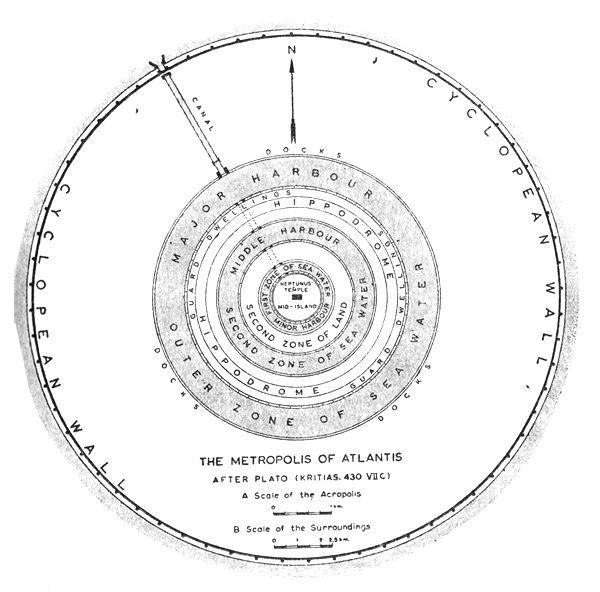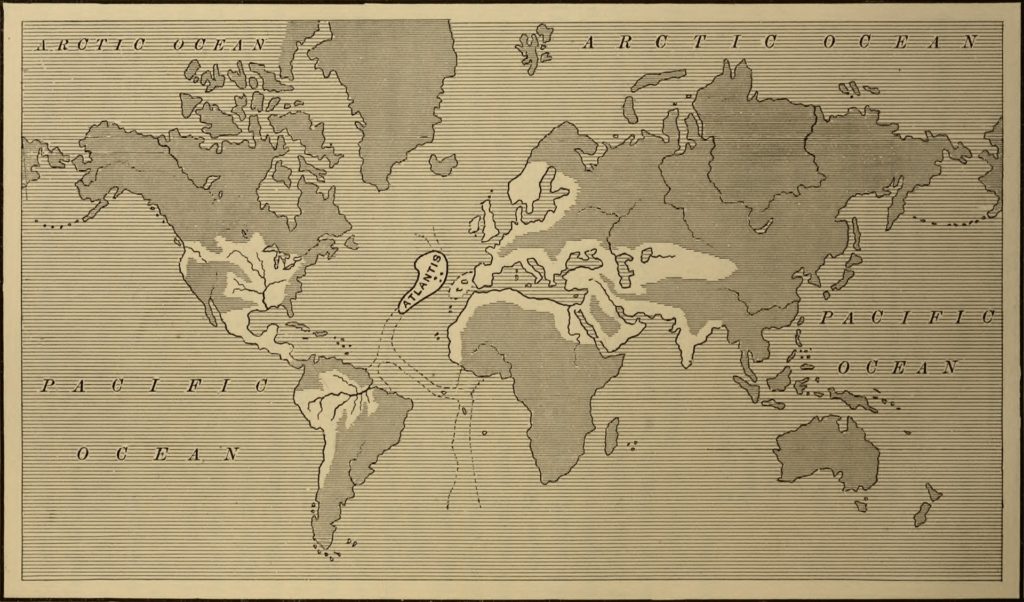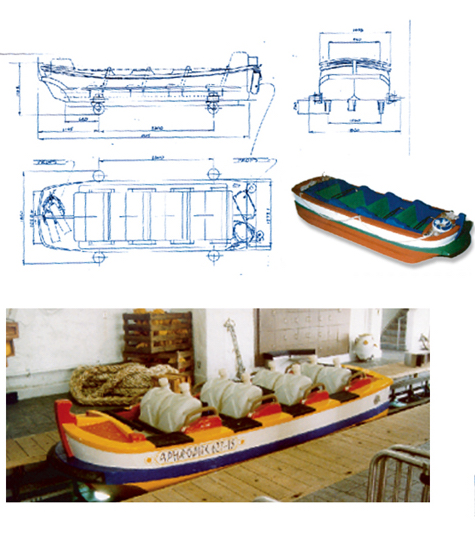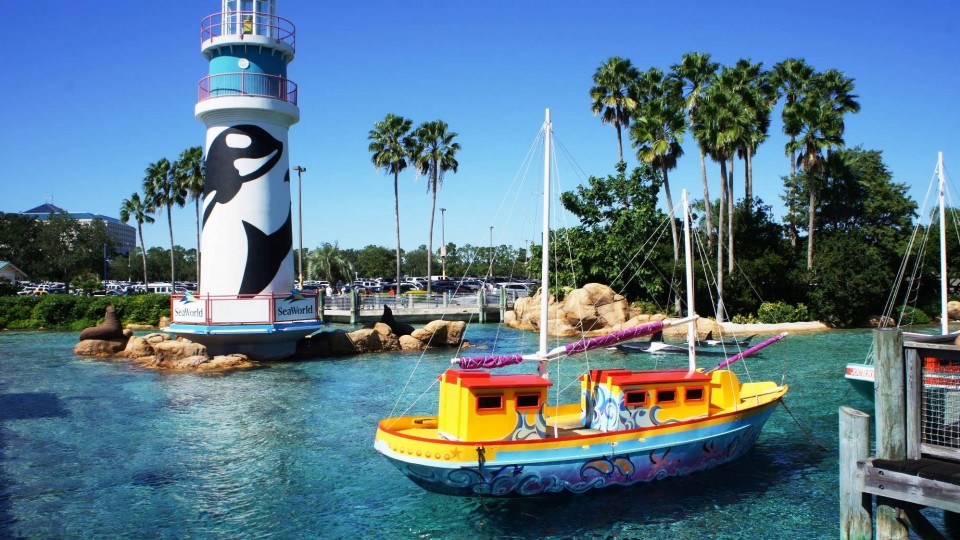The Legend of Atlantis

“Many great and wonderful deeds are recorded of your state in our histories. But one of them exceeds all the rest in greatness and valour. For these histories tell of a mighty power which, unprovoked, made an expedition against the whole of Europe and Asia, and to which your city put an end. This power came forth out of the Atlantic Ocean.
Now in this island of Atlantis there was a great and wonderful empire which had rule over the whole island and several others, and over parts of the continent, and, furthermore, the men of Atlantis had subjected the parts of Libya within the columns of Heracles as far as Egypt, and of Europe as far as Tyrrhenia. […]
But afterwards there occurred violent earthquakes and floods; and in a single day and night of misfortune […] the island of Atlantis in like manner disappeared in the depths of the sea.” – Plato’s Critias

Today, academics agree that when the great philosopher Plato spoke of an ancient metropolis called Atlantis in his Critias lectures around 400 BC, the vast oceanic city-state of unfathomable technology was meant as an allegory. The mythical “Atlantis” – which Plato himself dated to 9,000 years before his time – h was an invented antagonist to his idealized Athens; a world-conquering competitor who inevitably falls to his Republic.
Yet for millennia, the legend of the “Lost Continent” has spread to every corner of the globe. Storytellers imagine Atlantis as a supercontinent of unfathomably advanced technologies; a city built by the demigods; an entire lost civilization whose influence can be felt in – and thus, explains – the shared traditions and architecture of cultures around the globe; the precursor to the Greeks, Egyptians, and Phoenicians of old.

The legend of a sunken city dragged into the depths of the seas by the rage of the gods has inspired archaeologists, philosophers, treasure hunters, academics, and explorers for centuries. Expeditions to discover the remains of Atlantis cross the centuries.
Especially surprising given its relatively brief mention in Plato’s works, Atlantis has become a shared myth, its death as widely recognized as any religion’s creation story. Even the Atlantic Ocean’s Greek name – Ἀτλαντικῷ πελάγει – literally means Sea of Atlantis. A recurring setting in everything from ancient lore to modern films, Atlantis is a literary landmark. (The ruins of the city are even a stop for Captain Nemo in Jules Verne’s 1872 novel 20,000 Leagues Under the Sea and the Disney fan favorite attraction it inspired, the Lost Legend: 20,000 Leagues – Submarine Voyage).
And now, Atlantis itself would be the setting of SeaWorld’s most adventurous attraction yet – a truly astounding dark ride that would at last position the park as a worthy competitor to Disney and Universal, proving at last that SeaWorld could be a theme park contender…
Atlantis Rises
As tends to be the case with attractions that fall outside of Disney’s portfolio, the making of SeaWorld’s Journey to Atlantis is far less well-documented (and likewise, has far less legend surrounding it) than many of its ’90s contemporaries.

Much of what we know about the design behind SeaWorld’s Atlantis comes from attraction designer (and today, Principal Creative Director at Hotopp Creative Studio) Hector Caiazza. As a designer at PGVA Architects in the ’90s, Caiazza had already worked with SeaWorld to develop the scenic rockwork that had been affixed to various animal exhibits and public spaces at the park through the early ’90s… all a part of SeaWorld’s larger environmental strengthening as a theme park proper.
Contributing his style to the ancient city of Atlantis was a natural next step not only in building a strong conceptual look for the invented, mythic architecture, but in maintaining a consistent visual style and rockwork motif across the re-developing park.
Initially, the concept behind SeaWorld’s new attraction would’ve seen guests discover the destroyed ruins of Atlantis with ancient, crumbling structures, teetering columns, and debris representing the once-glorious city and its cataclysmic end. But according to Caiazza, the development of that concept occured before the 1995 Oklahoma City bombing, which killed 168 people, injured nearly 700 more, and saw images of collapsing destruction flood local news across the nation. Suddenly, fractured debris and steaming ruins didn’t seem a fitting exterior for a new anchor experience at SeaWorld.

Designers returned with the drawing board with a new direction handed down from SeaWorld: to develop a look for Atlantis that would be “beautiful, uplifting, and fun.” Caiazza’s draft (for Park Lore Members, above) absolutely fits the bill: a risen, sandstone city of cerulean domes, gold minarettes, and tile roofs, embedded in uplifted, seaweed-soaked rocks. A Grecian palace adorned with oceanic reliefs, steaming glass bowls, sealife mosaics, and hints of influence from across the ancient world…
Covering six acres and rising ten stories, this Atlantis wasn’t just a fitting icon for a park refocusing on myths of the sea. It also told a new story – not of a destroyed civilization, but of a returned one. Water and mist would pour from the palace as if only recently lifted from the ocean’s depths, mysteriously re-appeared along a white sand beach.

German ride manufacturer Mack Rides was brought in to develop an entirely new ride system for the attraction. Disguised as Greek fishing boats (again, in part by Caiazza), the ride’s vehicles would begin as free-floating, pushed along a water channel not unlike a traditional flume. But at key points along the ride’s course, the boats would hook into a track system, able to perform acrobatic roller coaster manuevers – the first installation of Mack’s now-famous Water Coaster model.
Even before the track was installed, cutting edge computer software allowed the team to digitally mock up the ride’s layout, anticipating sightlines, adjusting curves, and programming the reset time for special effects between boats.

In the tradition of the greatest Disney and Universal attractions, hundreds of artists, architects, sculptors, painters, and horticulturalists brought Atlantis to life. “The challenge typically was the budgets for Anheuser-Busch projects never compared to the budgets of Disney or Universal,” he recounted, “Yet my approach to any budgetary challenge is to see this as an incentive.”
The illusion of a grand, ancient palace was achieved on the cheap. According to the incredible documentation of former SeaWorld artist Sandra Johnson, most of Atlantis’ showbuilding was sculpted of foam and hard coat with paint used to add faux marble texture; many columns are hollow; archways that look made of ancient stone are actually so fragile, ladders can’t be leaned against them.

With development well underway on SeaWorld’s Atlantean adventure ride, there seemed to be just one thing missing: a name.
As the story goes, SeaWorld’s attempt to trademark the name “Journey to Atlantis” hit a sandbar when it was discovered that Universal Studios had already filed for the name – and recently. Hard at work on their own ambitious reimagining (by way of a second theme park in Orlando called Islands of Adventure), Universal had secured the name “Journey to Atlantis” for a walkthrough attraction that would see guests travel to the underwater kingdom to witness a special effects battle between the heroic Zeus and his archnemesis, Poseidon.

At least according to industry legend, SeaWorld wanted the name “Journey to Atlantis” badly enough to fight for it. Allegedly, SeaWorld indicated that they planned to file a legal objection to Universal’s use of the name “Islands of Adventure,” suggesting that it was close enough to the name of their own Tampa Bay waterpark – “Adventure Island” – that a reasonable person might be confused.
If you believe the story, SeaWorld and Universal mutually agreed to a compromise. In exchange for SeaWorld dropping its challenge against “Islands of Adventure,” Universal would forfeit the “Journey to Atlantis” trademark. (Their Atlantis-set special effects extravaganza was renamed, yielding fellow Declassified Disaster: Poseidon’s Fury: Escape from the Lost City.)
By early 1998, the SeaWorld Orlando’s new anchor attraction, Journey to Atlantis, was nearly ready. With the finishing touches in place, the park prepared for a 21st century relaunch that would position Journey to Atlantis as the hottest ticket in Orlando… What was it like to see the newly risen Atlantis in person? Let’s find out…
SeaWorld Adventure Park

April 1998. Waves of change have come to Orlando. There’s no doubt that the biggest news out of Central Florida is the opening of Disney’s Animal Kingdom – an unprecedented fourth gate at Walt Disney World and, just as importantly, a revolution for the themed entertainment industry. Animal Kingdom represents a new era of design – a park built with such realism, artistry, and depth, it’s the first in what will be a next generation of parks (with Universal’s Islands of Adventure to follow shortly after.)
Despite its starring feature being its animals, though, Disney wants to make it perfectly clear that Animal Kingdom is many things, but it’s “Nahtazū.” It’s got that in common with SeaWorld, which has undergone its own shift in focus with a similarly ambitious new direction… Gone are the days of placid animal exhibits and throwback entertainment.

This is the era of SeaWorld Adventure Parks – the next iteration of Busch Entertainment’s aquatic-animal-park-turned-destination-theme-park. Sure, a visit to SeaWorld will always include encounters with marine creatures… but now, SeaWorld isn’t just an educational, entertaining, and transformational zoo; it’s an adventure, pulling you into the magic, mystery, and majesty of the ocean, exploring our connection to it, and bringing you into the stories we tell about it.

The adventure begins in a new harbor – part of a grand redesign of the park’s entry. Crystalline waves lap against coastal rocks as Technicolor boats bob amid schooling cernamic orcas. If Magic Kingdom has Main Street, than our journey through SeaWorld fittingly begins on the docks and boardwalks of the park’s entry – the natural departure point for ports unknown and seas beyond!
And speaking of which, the destination today has to be the park’s newest ride. Will the much-talked-about Journey to Atlantis put SeaWorld Orlando on the map? Read on…



Enjoy your articles very much, though this one left me feeling perhaps it wasn’t as ‘impartial’ as they usually are? I dunno; usually you include the description/walkthrough of the ride as it originally was, but halfway through this one you switched to how it ended up, and even came across a bit short? “We get it, she’s the villain” or something to that effect.
Just something I noticed. Not a fan of this one?
Either way, I love this ride and am sad to see what it has become. When I first moved to the area back in 2004ish, my family had annual passes to everything, and we spent a lot of time at all the parks. I’ve ridden this one a lot in the years since. I thought it was a quaint little story that wasn’t thrust in your face, and the ride itself with the surprise coaster was great. Though yes, the effects etc were not Disney quality of course.
Though I know I had plenty of times where there wasn’t a syncing issue with Hermes at the start at the ride. Surely that must have come later on? Or maybe I was really really lucky.
Either way. I do wish they would put effort in to restoring Allura and Hermes with current tech, but at this point it seems so doubtful. So sad. 🙁
Thanks so much for sharing this! I can definitely admit that I’m not always great at being impartial… especially in the Disaster series! 😛 It’s tough especially with Journey to Atlantis because I think it’s lived three lives: what it was meant to be, what it became, and what it is now. It’s really a sad story to see the “solution” to the ride’s issues be to essentially give up on it, because like you said, it had all the makings of a really nice story and some impressive effects!
To your point, I’ll look back over this story and make sure I’m doing it justice. I always try to keep in mind that even “bad” rides (or rides that end up “bad”) have been loved by millions upon millions of people with meaningful memories tied to it! If I missed the mark here in keeping this story balanced, that’s something I’ll want to fix. Thanks for bringing it to my attention and thanks so much for reading!
I rode J2A many times. I didn’t think the original version was that bad. I enjoyed it immensely. However, the last time I rode it (2018), I was very disappointed. Sure I’d seen videos of the “enhanced” version, but experiencing it was a different story. I didn’t like what they did to “my ride”. All the elements that made the ride fun were either removed or turned off. I usually rode the “original” version 2-3 times of lines weren’t bad and if we had time. However, I only rode the “enhanced” version once and I was done. I don’t know what they did with the main drop during that year’s refurbishment, but the boat jerked very hard at the bottom of it and I think I experienced some whiplash. Not riding it again, I don’t think.